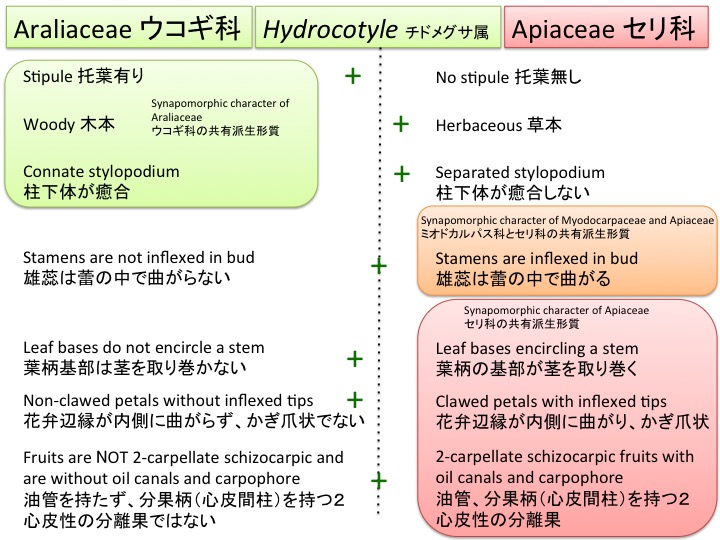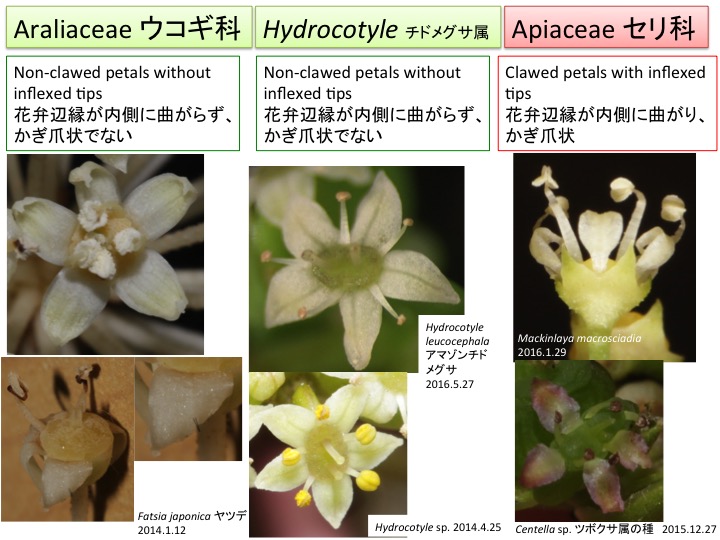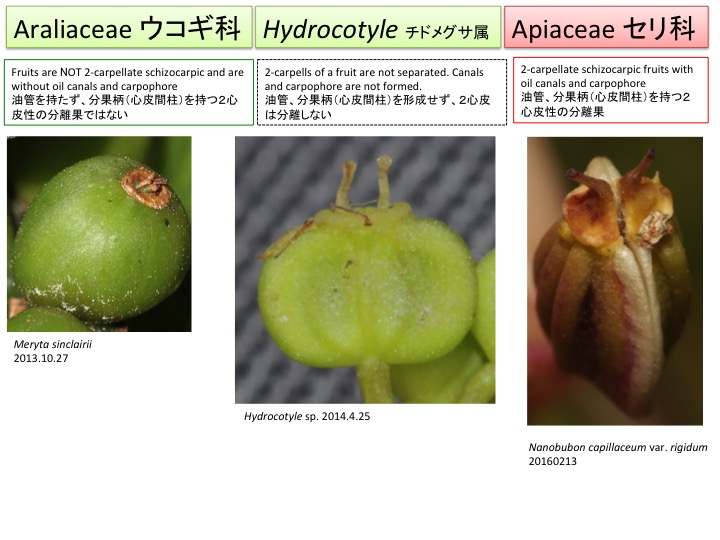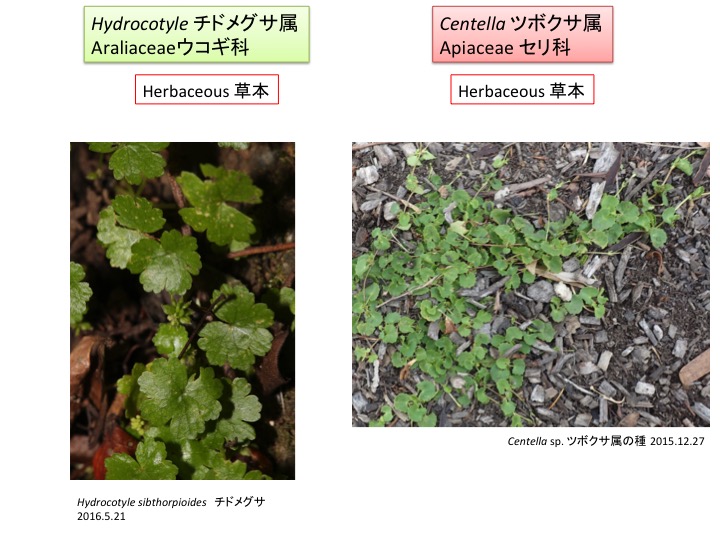Nicolas, A.N. and Plunkett, G.M. 2009. The demise of subfamily Hydrocotyloideae (Apiaceae) and the re-alignment of its genera across the entire order Apiales. Molec. Phylogenet. Evol. 53: 134-151.
チドメグサ属と関連属はセリ科に分類されてきたが、塩基配列情報を用いた系統推定によってウコギ科に属する可能性が高いことがわかった (例えば Nicolas and Plunkett 2009)。
Hydrocotyle and its close relatives have been treated as a member of the Apiaceae but phylogenetic analyses using nucleotide sequences support the inclusion in the Araliaceae (e.g. Nicolas and Plunkett 2009).
Nicolas, A.N. and Plunkett, G.M. 2009. The demise of subfamily Hydrocotyloideae (Apiaceae) and the re-alignment of its genera axross the entire order Apiales. Molec. Phylogenet. Evol. 53: 134-151.
チドメグサ属はいくつかの形態形質をウコギ科と共有しているが、他の形態形質はセリ科と共有している。似ている方に+の印を付けた。両科の中間的な形態をしている場合は点線の上に+印を付けた。
Hydrocotyle shares some morphological characters with the Araliaceae but other ones with the Apiaceae. Morphological characters of Hydrocotyle are indicated as plus marks. When Hydrocotyle has intermediate morphology, plus mark is shown on the dotted line.
ヤツデの托葉は葉柄と癒合している。
Stipules of Fatsia japonica is connate to a petiole.
ウコギ科のほとんどは木本性だがセリ科のほとんどは草本性である。チドメグサ属は草本である。
The Araliaceae are mostly composed of woody species, while the Apiaceae are of herbaceous species. Hydrocotyle is herbaceous.
ウコギ科では、それぞれの花柱の基部に形成される柱下体が癒合するが、セリ科は癒合しない。チドメグサ属は癒合しておらずセリ科に似ている。
Stylopodia at the base of styles are connate in the Araliaceae, but are not connate in the Apiaceae. Stylopodia of Hydrocotyle are not connate as that of the Apiaceae.
加えて、チドメグサ属はセリ科のツボクサ属に似ている。チドメグサ属の形態形質を緑色の+印、ツボクサ属の形態形質を赤色の+印で示した。
In addition, Centella in the Apiaceae is similar to Hydrocotyle. Morphological characters of Centella and Hydrocotyle are shown as red and green plus marks, respectively.
柱下体は両種とも癒合しないが、花柱の位置する場所が異なる。チドメグサ属では花柱は柱下体の中央部あたりに位置するが、ツボクサでは心皮の境界部分に位置する。
Stylopodia are not connate in both species, but position of styles are different between them. Styles are positioned at the center of each stylopodium in Hydrocotyle, while they are positioned at the border of two carpels in Centella.
チドメグサ属の花弁はウコギ科、ツボクサ属の花弁はセリ科の多くが持つ特徴に合致する。一方、雄蕊形態はやや曲がり、ともにウコギ科とセリ科の中間的な形態である。
Petals of Hydrocotyle and Centella are similar to those in the Araliaceae and the Apiaceae, respectively. Stamens of both genera are slightly bend and intermediate between both families.
托葉や葉の基部形態は二属で異なっている。
Morphology at the leaf base and stipules is different between two genera.
さらに、チドメグサ属とツボクサ属は、ウコギ科とセリ科の両者の中で稀な次の3つの形態形質を共有している。1)茎が長く這う点、2)匍匐茎から不定根を形成する、3)花序を腋生する。これらのことから、チドメグサ属はツボクサ属に近縁、すなわち、セリ科に属すると考えられてきた。ただ、よく観察するとチドメグサ属の花序は腋生ではない。
Furthermore, Hydrocotyle and Centella share the following three special morphological characters that are not popular in both Araliaceae and Apiaceae: 1) the creeping stem, 2) adventitious roots from nodes, and 3) axillary inflorescences. Therefore, Hydrocotyle was classified into the Apiaceae. However, with careful observation, inflorescences of Hydrocotyle are not axillary.
セリ科のツボクサ属では、花序は葉腋に形成され、蔓状のシュートは単軸分枝である。
Inflorescences of Centella in the Apiaceae are axillary. The creeping shoot is monopodial.
 アマゾンチドメグサの花序は葉の腋ではなく、葉と対生の位置に形成される。このことは、このシュートは仮軸分枝で、花序が頂端で、蔓の先端部は葉腋にできた腋芽である可能性を示唆している。右の写真では主腋芽と葉の間に副芽が形成されている。
アマゾンチドメグサの花序は葉の腋ではなく、葉と対生の位置に形成される。このことは、このシュートは仮軸分枝で、花序が頂端で、蔓の先端部は葉腋にできた腋芽である可能性を示唆している。右の写真では主腋芽と葉の間に副芽が形成されている。
An inflorescence of Hydrocotyle leucocephala is not formed at the axil of a leaf but rather in an opposite position. This suggests sympodial branching, in which an inflorescence is a terminal shoot and an extending vegetative shoot is an axillary shoot of a leaf. In the right picture, a secondary axillary shoot is formed between a main axillary shoot and a leaf.
チドメグサの場合も花序が頂生し、仮軸分枝によって茎が形成されている。
Sympodial branching is also observed in Hydrocotyle sibthorpioides.






















